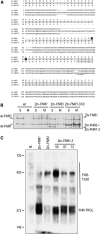N-terminal structure of maize ferredoxin:NADP+ reductase determines recruitment into different thylakoid membrane complexes
- PMID: 22805436
- PMCID: PMC3426127
- DOI: 10.1105/tpc.111.094532
N-terminal structure of maize ferredoxin:NADP+ reductase determines recruitment into different thylakoid membrane complexes
Abstract
To adapt to different light intensities, photosynthetic organisms manipulate the flow of electrons through several alternative pathways at the thylakoid membrane. The enzyme ferredoxin:NADP(+) reductase (FNR) has the potential to regulate this electron partitioning because it is integral to most of these electron cascades and can associate with several different membrane complexes. However, the factors controlling relative localization of FNR to different membrane complexes have not yet been established. Maize (Zea mays) contains three chloroplast FNR proteins with totally different membrane association, and we found that these proteins have variable distribution between cells conducting predominantly cyclic electron transport (bundle sheath) and linear electron transport (mesophyll). Here, the crystal structures of all three enzymes were solved, revealing major structural differences at the N-terminal domain and dimer interface. Expression in Arabidopsis thaliana of maize FNRs as chimeras and truncated proteins showed the N-terminal determines recruitment of FNR to different membrane complexes. In addition, the different maize FNR proteins localized to different thylakoid membrane complexes on expression in Arabidopsis, and analysis of chlorophyll fluorescence and photosystem I absorbance demonstrates the impact of FNR location on photosynthetic electron flow.
Figures







References
-
- Andersen B., Scheller H.V., Møller B.L. (1992). The PSI-E subunit of photosystem I binds ferredoxin:NADP+ oxidoreductase. FEBS Lett. 311: 169–173 - PubMed
-
- Arnon D.I., Tagawa K., Tsujimoto H.Y. (1963). Role of ferredoxin in the energy conversion process of photosynthesis. Science 140: 378. - PubMed
-
- Baniulis D., Zhang H., Zakharova T., Hasan S.S., Cramer W.A. (2011). Purification and crystallization of the cyanobacterial cytochrome b6f complex. Methods Mol. Biol. 684: 65–77 - PubMed
-
- Benz J.P., Lintala M., Soll J., Mulo P., Bölter B. (2010). A new concept for ferredoxin-NADP(H) oxidoreductase binding to plant thylakoids. Trends Plant Sci. 15: 608–613 - PubMed
Publication types
MeSH terms
Substances
LinkOut - more resources
Full Text Sources
Molecular Biology Databases

